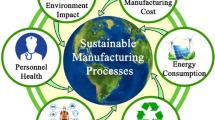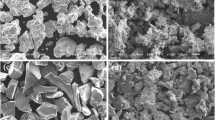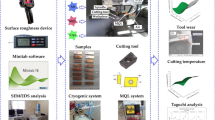Abstract
Hybrid composites are at the forefront of technological developments due to their high thermal conductivity and thermal stability requirements. Hybrid composites are complex to machining due to the hard reinforcement particles contained in them and may cause structural defects. For this reason, although they are at the forefront, they are not preferred much in the manufacturing industry. This study was carried out to increase the machining efficiency of hybrid composites and, at the same time, to encourage the use of these composites in industry by reducing the environmental impact. In this study, the effects of different cooling/lubrication conditions on the surface roughness, tool wear, cutting temperature, and energy consumption of Cu–6Gr/SiC–WC hybrid composites by CNC milling were investigated. For this purpose, six material types (1–2–3–4–5–6), three cutting speeds (150–200–250 m/min), three feed rates (0.15–0.20–0.25 mm/rev), and three cooling/lubrication environment (dry-MQL-cryo-LN2) was selected. It was determined that the best option in terms of surface quality is the MQL environment. Cryo-LN2 environment reduces tool wear, cutting temperature, and energy consumption by 67%, 31%, and 14%, respectively, compared to the dry environment. Additionally, the wear mechanisms occurring on the cutting tool were examined by SEM/EDS analysis. In general, the cryo-LN2 strategy can be used as the best option for sustainable milling of hybrid composites. The results obtained are promising for using Cu–6Gr composites in the manufacturing industry, and these results are seen as innovations for the machinability results of hybrid composites.











Similar content being viewed by others
References
Zhang X, Chen Y, Hu J (2018) Recent advances in the development of aerospace materials. Prog Aerosp Sci 97:22–34
Bayraktar Ş, Afyon F (2020) Machinability properties of Al–7Si, Al–7Si–4Zn and Al–7Si–4Zn–3Cu alloys. J Braz Soc Mech Sci Eng 42(4):187
Rajeswari B, Amirthagadeswaran KS (2018) Study of machinability and parametric optimization of end milling on aluminium hybrid composites using multi-objective genetic algorithm. J Braz Soc Mech Sci Eng 40(8):377
Wang S, Li Y, Wang J, Luo T, Zheng K, Zheng Z et al (2022) Study on the microstructure and properties of iron-based composites locally reinforced by in-situ submicron TiC particles. Mater Chem Phys 287:126376
Şap S (2023) Mechanical and tribological behaviour of novel Al–12Si-based hybrid composites. Mater Test 65(4):560–577
Akbarpour MR, Alipour S, Safarzadeh A, Kim HS (2019) Wear and friction behavior of self-lubricating hybrid Cu-(SiC + x CNT) composites. Compos Part B Eng 158:92–101
Ebrahimi M, Wang Q, Attarilar S (2023) A comprehensive review of magnesium-based alloys and composites processed by cyclic extrusion compression and the related techniques. Prog Mater Sci 131:101016
Wei H, Feng G, Li X, Zhan W, Li F, Dai Y et al (2023) Copper-graphite-TiC composites-synthesis and microstructure investigation. Mater Lett 351:135005
Usca ÜA, Şap S, Uzun M (2023) Evaluation of Machinability of Cu Matrix Composite Materials by Computer Numerical Control Milling under Cryogenic LN2 and Minimum Quantity Lubrication. J Mater Eng Perform 32(5):2417–2431
Liew WYH, Ding X (2008) Wear progression of carbide tool in low-speed end milling of stainless steel. Wear 265(1):155–166
Değirmenci Ü, Usca ÜA, Şap S (2023) Machining characterization and optimization under different cooling/lubrication conditions of Al-4Gr hybrid composites fabricated by vacuum sintering. Vacuum 208:111741
Suneesh E, Sivapragash M (2019) Parameter optimisation to combine low energy consumption with high surface integrity in turning Mg/Al2O3 hybrid composites under dry and MQL conditions. J Braz Soc Mech Sci Eng 41(2):89
Das CR, Ghosh A (2023) Performance of carbide end mills coated with new generation nano-composite TiAlSiN in machining of austenitic stainless steel under near-dry (MQL) and flood cooling conditions. Manuf Process 104:418–442
Şap S (2023) Understanding the machinability and energy consumption of Al-based hybrid composites under sustainable conditions. Lubricants 11(3):111
Guntreddi B, Ghosh A (2020) High-speed machining of aluminium alloy using vegetable oil based small quantity lubrication. Proc Inst Mech Eng B J Eng Manuf. https://doi.org/10.1177/0954405420929787
Chen J, Yu W, Zuo Z, Li Y, Chen D, An Q et al (2021) Tribological properties and tool wear in milling of in-situ TiB2/7075 Al composite under various cryogenic MQL conditions. Tribol Int 160:107021
Hukkerikar AV, Arrazola P-J, Aristimuño P, Norgren S, Morandeau A, Joly D (2023) A tribological characterisation of Ti–48Al–2Cr–2Nb and Ti–6Al–4V alloys with dry, flood, and MQL lubricants. CIRP J Manuf Sci Technol 41:501–523
Nimel Sworna Ross K, Manimaran G (2019) Effect of cryogenic coolant on machinability of difficult-to-machine Ni–Cr alloy using PVD-TiAlN coated WC tool. J Braz Soc Mech Sci Eng 41(1):44
Şirin Ş (2022) Investigation of the performance of cermet tools in the turning of Haynes 25 superalloy under gaseous N2 and hybrid nanofluid cutting environments. Manuf Process 76:428–443
Chetan GS, Rao PV (2019) Comparison between sustainable cryogenic techniques and nano-MQL cooling mode in turning of nickel-based alloy. J Clean Prod 231:1036–1049
Aramcharoen A (2016) Influence of cryogenic cooling on tool wear and chip formation in turning of titanium alloy. Procedia CIRP 46:83–86
Bordin A, Sartori S, Bruschi S, Ghiotti A (2017) Experimental investigation on the feasibility of dry and cryogenic machining as sustainable strategies when turning Ti6Al4V produced by Additive Manufacturing. J Clean Prod 142:4142–4151
Gupta MK, Korkmaz ME, Sarıkaya M, Krolczyk GM, Günay M, Wojciechowski S (2022) Cutting forces and temperature measurements in cryogenic assisted turning of AA2024-T351 alloy: an experimentally validated simulation approach. Measurement 188:110594
Shokrani A, Dhokia V, Newman ST (2016) Investigation of the effects of cryogenic machining on surface integrity in CNC end milling of Ti–6Al–4V titanium alloy. Manuf Process 21:172–179
Usca ÜA (2023) The effect of cellulose nanocrystal-based nanofluid on milling performance: an investigation of dillimax 690T. Polymers 15(23):4521
Demirpolat H, Binali R, Patange AD, Pardeshi SS, Gnanasekaran S (2023) Comparison of tool wear, surface roughness, cutting forces, tool tip temperature, and chip shape during sustainable turning of bearing steel. Materials 16(12):4408
Binali R, Demirpolat H, Kuntoğlu M, Salur E (2023) Different aspects of machinability in turning of AISI 304 stainless steel: a sustainable approach with MQL technology. Metals 13(6):1088
Makhesana MA, Patel KM, Krolczyk GM, Danish M, Singla AK, Khanna N (2023) Influence of MoS2 and graphite-reinforced nanofluid-MQL on surface roughness, tool wear, cutting temperature and microhardness in machining of Inconel 625. CIRP J Manuf Sci Technol 41:225–238
Usca ÜA, Şap S, Uzun M, Giasin K, Pimenov DY (2022) Evaluation of mechanical and tribological aspect of self-lubricating Cu–6Gr composites reinforced with SiC–WC hybrid particles. Nanomater Basel 12(13):2154
Liu J, Sun K, Zeng L, Wang J, Xiao X, Liu J et al (2020) Microstructure and properties of copper-graphite composites fabricated by spark plasma sintering based on two-step mixing. Metals 10(11):1506
Park K-H, Olortegui-Yume J, Yoon M-C, Kwon P (2010) A study on droplets and their distribution for minimum quantity lubrication (MQL). Int J Mach Tools Manuf 50(9):824–833
Yıldırım ÇV, Kıvak T, Erzincanlı F (2019) Tool wear and surface roughness analysis in milling with ceramic tools of Waspaloy: a comparison of machining performance with different cooling methods. J Braz Soc Mech Sci Eng 41(2):83
Suresh Kumar Reddy N, Kwang-Sup S, Yang M (2008) Experimental study of surface integrity during end milling of Al/SiC particulate metal–matrix composites. J Mater Process Technol 201(1):574–579
Şap E, Usca ÜA, Uzun M (2022) Machining and optimization of reinforced copper composites using different cooling-lubrication conditions. J Braz Soc Mech Sci Eng 44(9):399
Korkmaz ME, Gupta MK, Günay M, Boy M, Yaşar N, Demirsöz R et al (2023) Comprehensive analysis of tool wear, surface roughness and chip morphology in sustainable turning of Inconel-601 alloy. Manuf Process 103:156–167
Thakur A, Manna A, Samir S (2019) Experimental investigation of nanofluids in minimum quantity lubrication during turning of EN-24 steel. Proc Inst Mech Eng J J Eng Tribol 234(5):712–729
Şap E, Usca UA, Gupta MK, Kuntoğlu M (2021) Tool wear and machinability investigations in dry turning of Cu/Mo-SiCp hybrid composites. Int J Adv Manuf Technol 114(1):379–396
Tapoglou N, Lopez MIA, Cook I, Taylor CM (2017) Investigation of the influence of CO2 cryogenic coolant application on tool wear. Procedia CIRP 63:745–749
Boswell B, Islam MN, Davies IJ, Ginting YR, Ong AK (2017) A review identifying the effectiveness of minimum quantity lubrication (MQL) during conventional machining. Int J Adv Manuf Technol 92(1):321–340
Khanna N, Shah P, Chetan (2020) Comparative analysis of dry, flood, MQL and cryogenic CO2 techniques during the machining of 15-5-PH SS alloy. Tribol Int 146:106196
Duc TM, Long TT, Chien TQ (2019) Performance evaluation of MQL parameters using Al2O3 and MoS2 nanofluids in hard turning 90CrSi steel. Lubricants 7(5):40
Pu Z, Outeiro JC, Batista AC, Dillon OW, Puleo DA, Jawahir IS (2012) Enhanced surface integrity of AZ31B Mg alloy by cryogenic machining towards improved functional performance of machined components. Int J Mach Tools Manuf 56:17–27
Aslan A (2020) Optimization and analysis of process parameters for flank wear, cutting forces and vibration in turning of AISI 5140: a comprehensive study. Measurement 163:107959
Sharma VS, Dogra M, Suri NM (2009) Cooling techniques for improved productivity in turning. Int J Mach Tools Manuf 49(6):435–453
Salur E (2022) Understandings the tribological mechanism of Inconel 718 alloy machined under different cooling/lubrication conditions. Tribol Int 174:107677
Sivaiah P, Chakradhar D (2018) Effect of cryogenic coolant on turning performance characteristics during machining of 17–4 PH stainless steel: a comparison with MQL, wet, dry machining. CIRP J Manuf Sci Technol 21:86–96
Yildiz Y, Nalbant M (2008) A review of cryogenic cooling in machining processes. Int J Mach Tools Manuf 48(9):947–964
Şap S, Usca ÜA, Uzun M, Kuntoğlu M, Salur E, Pimenov DY (2022) Investigation of the effects of cooling and lubricating strategies on tribological characteristics in machining of hybrid composites. Lubricants 10(4):63
Binali R, Demirpolat H, Kuntoğlu M, Sağlam H (2023) Machinability investigations based on tool wear, surface roughness, cutting temperature, chip morphology and material removal rate during dry and MQL-assisted milling of Nimax mold steel. Lubricants 11(3):101
Öndin O, Kıvak T, Sarıkaya M, Yıldırım ÇV (2020) Investigation of the influence of MWCNTs mixed nanofluid on the machinability characteristics of PH 13–8 Mo stainless steel. Tribol Int 148:106323
Danish M, Gupta MK, Rubaiee S, Ahmed A, Mahfouz A, Jamil M (2021) Machinability investigations on CFRP composites: a comparison between sustainable cooling conditions. Int J Adv Manuf Technol 114(11):3201–3216
Usluer E, Emiroğlu U, Yapan YF, Kshitij G, Khanna N, Sarıkaya M et al (2023) Investigation on the effect of hybrid nanofluid in MQL condition in orthogonal turning and a sustainability assessment. SMT 36:e00618
Singh R, Dureja JS, Dogra M, Kumar Gupta M, Jamil M, Mia M (2020) Evaluating the sustainability pillars of energy and environment considering carbon emissions under machining of Ti–3Al–2.5V. Sustain Energy Technol Assess 42:100806
Yildiz T, Gür AK, Aba S (2014) Examination of the wear behavior of Cu–Ni/B4Cp composite by the Taguchi method. Mater Test 56(11–12):1009–1014
Yang WH, Tarng YS (1998) Design optimization of cutting parameters for turning operations based on the Taguchi method. J Mater Process Technol 84(1):122–129
Veličković S, Stojanović B, Babić M, Bobić I (2016) Optimization of tribological properties of aluminum hybrid composites using Taguchi design. J Compos Mater 51(17):2505–2515
Venkatesan K, Ramanujam R (2016) Statistical approach for optimization of influencing parameters in laser assisted machining (LAM) of Inconel alloy. Measurement 89:97–108
Funding
The authors received no financial support for the research, authorship, or publication of this work.
Author information
Authors and Affiliations
Corresponding authors
Ethics declarations
Conflict of interest
The authors explicitly declared the absence of any potential conflicts of interest pertaining to the research, authorship, and/or publication of this manuscript.
Additional information
Technical Editor: Diego Carou Porto.
Publisher’s Note
Springer Nature remains neutral with regard to jurisdictional claims in published maps and institutional affiliations.
Rights and permissions
Springer Nature or its licensor (e.g. a society or other partner) holds exclusive rights to this article under a publishing agreement with the author(s) or other rightsholder(s); author self-archiving of the accepted manuscript version of this article is solely governed by the terms of such publishing agreement and applicable law.
About this article
Cite this article
Usca, Ü.A., Şap, S., Uzun, M. et al. Assessment of the machinability and energy consumption characteristics of Cu–6Gr hybrid composites under sustainable operating. J Braz. Soc. Mech. Sci. Eng. 46, 221 (2024). https://doi.org/10.1007/s40430-024-04815-z
Received:
Accepted:
Published:
DOI: https://doi.org/10.1007/s40430-024-04815-z




